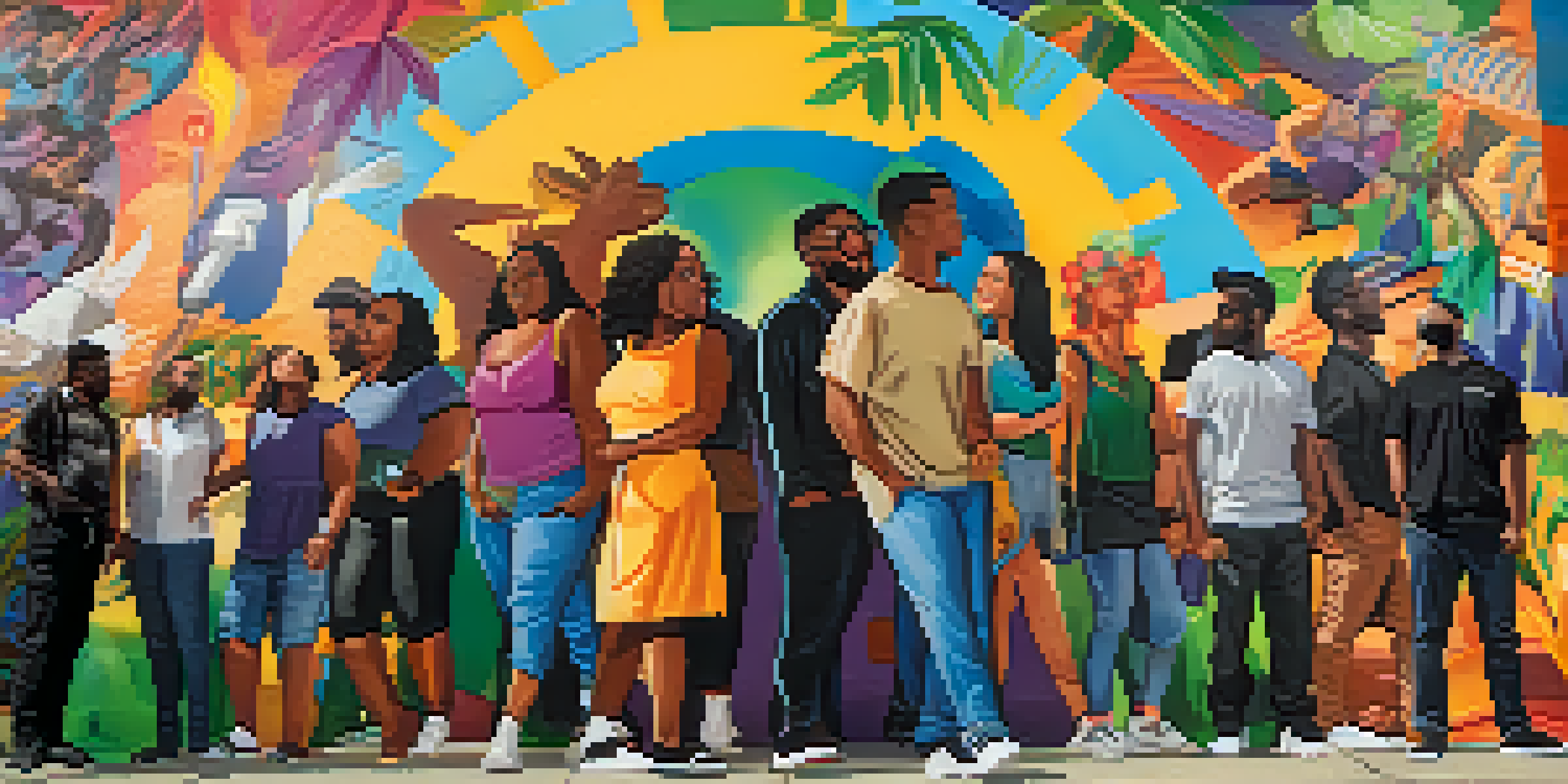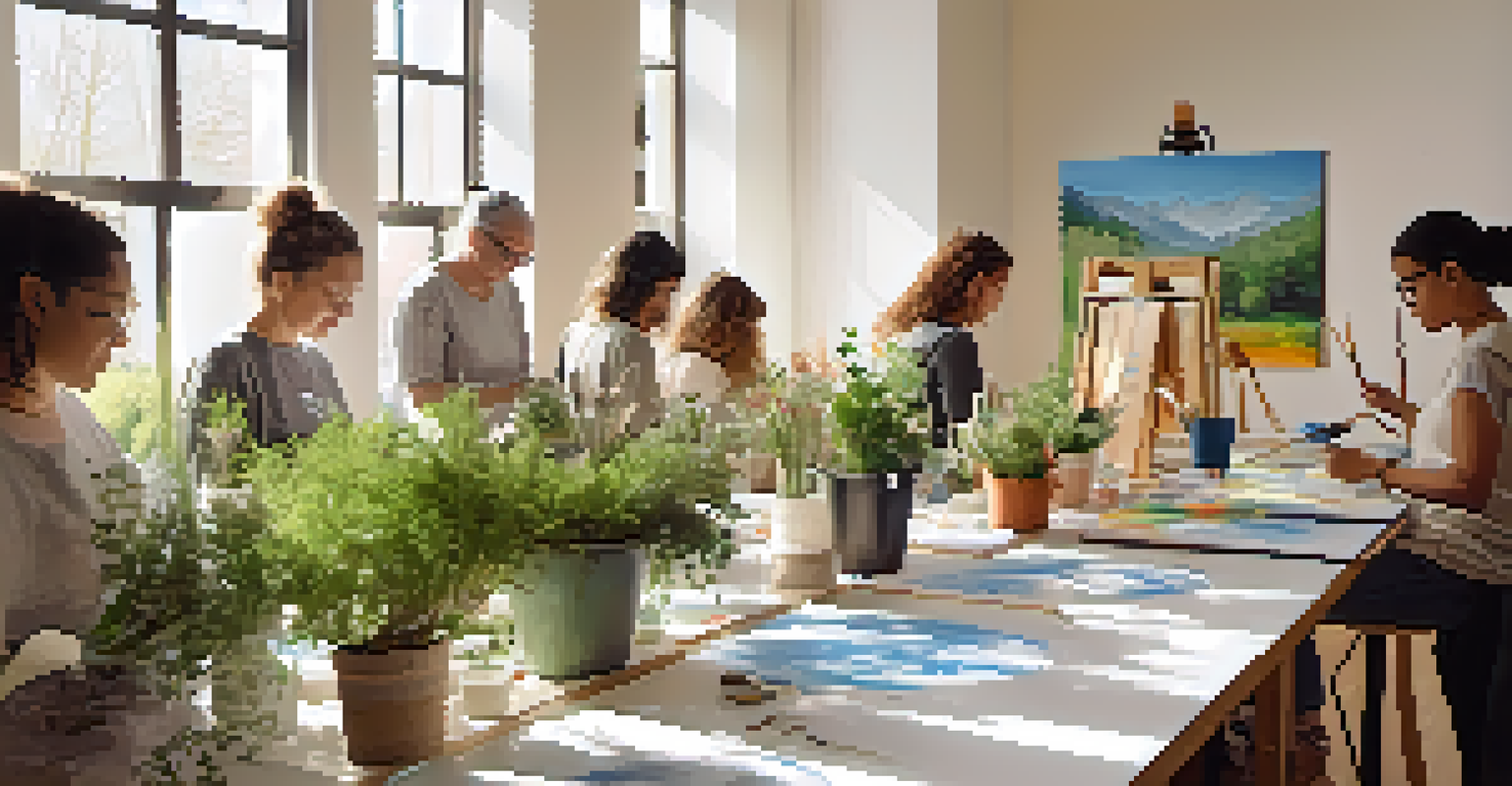Art and Human Rights: Creative Responses to Social Injustice

The Power of Art in Highlighting Social Injustice
Art has always served as a mirror to society, reflecting its triumphs and failures. When it comes to social injustice, artists often take on the role of advocates, using their work to shine a light on issues that might otherwise go unnoticed. For example, street art has emerged as a powerful medium for voicing dissent and raising awareness about systemic problems like racism and inequality.
Art is not a mirror held up to reality but a hammer with which to shape it.
Through visual storytelling, artists can evoke empathy and provoke thought, making complex issues more accessible to the general public. A poignant mural or an evocative sculpture can ignite conversations and inspire action in ways that statistics and reports cannot. This creative approach helps to humanize the struggles faced by marginalized communities.
Moreover, art transcends language and cultural barriers, allowing it to resonate with diverse audiences. In a world where social media amplifies messages, powerful artwork can go viral, reaching millions and sparking movements for change.
Art as a Form of Protest and Resistance
Throughout history, art has been a vital tool for protest and resistance against oppressive regimes. From the powerful anti-war songs of the 1960s to the bold political statements made through contemporary performance art, creativity has forged a path for dissenters. Artists often risk their safety to express their beliefs through their work, showcasing the potent connection between art and activism.

Consider the work of artists like Ai Weiwei, whose installations challenge the Chinese government’s censorship and human rights abuses. His art is not just for aesthetics; it serves as a rallying cry for those who feel voiceless. Such examples highlight how art can galvanize communities and foster solidarity among those fighting for justice.
Art as Advocacy for Social Issues
Artists use their work to highlight social injustices, fostering empathy and inspiring action through visual storytelling.
This trend of using art as resistance continues today, with many artists choosing to create pieces that confront social injustices directly. It demonstrates that creativity can be a powerful weapon in the fight against oppression, inspiring others to join the cause.
Storytelling Through Visual Arts and Literature
Visual arts and literature have a unique ability to tell stories that resonate deeply with audiences. Through paintings, photography, and literature, artists can convey the lived experiences of individuals facing injustice, allowing viewers to connect on a personal level. This storytelling aspect is crucial in fostering empathy and understanding of complex social issues.
The purpose of art is not a rarified, intellectual distillate; it is life, intensified, illuminated, a moment of vision, a moment of hope.
For instance, novels like 'The Kite Runner' by Khaled Hosseini provide insight into the struggles of Afghan families amidst war and displacement. Similarly, powerful photography can capture the stark realities of poverty and violence, leaving a lasting impact on viewers. These narratives not only inform but also inspire action, encouraging others to contribute to social change.
Furthermore, storytelling through art can preserve cultural histories that might otherwise be lost to time. By documenting the experiences of marginalized communities, artists ensure their voices are heard and remembered, fostering a greater appreciation for diversity and resilience.
The Role of Music in Social Movements
Music has long played a significant role in social movements, serving as both a unifying force and a means of expression. From protest songs during the civil rights movement to contemporary anthems advocating for climate justice, music has the power to inspire and mobilize people. It can evoke strong emotions and create a sense of community among those fighting for a common cause.
Artists like Billie Holiday, with her haunting song 'Strange Fruit,' brought attention to the horrors of racism and lynching in America. Similarly, modern musicians continue to use their platforms to speak out against injustice, encouraging listeners to reflect on their own beliefs and actions. This connection between music and social justice underlines how sound can be a catalyst for change.
Music Unites for Social Change
Music serves as a powerful tool for expression and activism, rallying communities around common causes throughout history.
Moreover, music festivals and concerts often become spaces for activism, where attendees are encouraged to engage with social issues. This blend of entertainment and advocacy demonstrates the profound impact of music on culture and its potential to drive social change.
Dance as a Medium for Social Commentary
Dance is yet another powerful form of artistic expression that can address social injustices. Choreographers and dancers often use movement to convey messages about societal issues, allowing audiences to experience emotions and narratives in a visceral way. Through dance, complex themes such as oppression, identity, and resilience can be communicated without the need for words.
For example, the work of Alvin Ailey American Dance Theater blends African American cultural heritage with contemporary dance, addressing themes of struggle and hope. These performances not only entertain but also educate audiences about the history and ongoing challenges faced by marginalized communities. Dance becomes a form of storytelling that transcends language barriers and speaks directly to the heart.
Moreover, community dance projects often involve participants from diverse backgrounds, fostering dialogue and understanding among different groups. This inclusive approach reinforces the idea that art can unite people in the fight for social justice, creating a sense of shared purpose.
The Impact of Digital Art and Social Media
In today's digital age, art has found new platforms for expression and activism through social media. Artists can share their work with global audiences instantaneously, raising awareness about social injustices and mobilizing support for various causes. This shift has democratized art, allowing emerging voices to be heard alongside established creators.
Digital art, including graphic design, memes, and videos, can effectively communicate messages in a visually engaging way. For instance, the viral hashtag campaigns like #BlackLivesMatter utilize striking imagery and powerful messages to spark conversations about racism and police violence. This blend of art and activism highlights how technology can enhance the reach and impact of artistic expression.
Digital Art Amplifies Voices
In the digital age, social media allows artists to share their messages widely, mobilizing support and raising awareness for social injustice.
Social media has also become a space for artists to collaborate and engage with their communities directly. By fostering dialogue and sharing personal stories, digital platforms can amplify the voices of those fighting for social justice, creating a collective movement for change.
Art Therapy and Healing in the Face of Injustice
Art therapy has emerged as a significant tool for healing in communities affected by social injustice. Creative expression can provide individuals with a safe space to process their emotions and experiences, helping them cope with trauma and grief. This therapeutic approach recognizes the power of art not just as a form of protest, but also as a path to personal and collective healing.
Through workshops and programs, people can engage in various artistic practices, such as painting, writing, or music, to express their feelings and share their stories. This process can foster a sense of community and support, as participants connect with others who have faced similar struggles. It emphasizes the importance of mental health and well-being in the fight for social justice.

Additionally, art therapy can empower individuals by giving them a voice and a means to reclaim their narratives. This transformative power of art underscores its role not only in advocating for change but also in nurturing resilience and healing within communities.